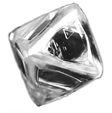Diamonds, a natural mineral composed of pure carbon
Thanks to the numerous attempts to create artificial diamonds in a laboratory, we now know the conditions in which diamonds are formed. The birth of a diamond will have occurred in extreme conditions.
It is estimated temperatures between 1,300 and 400°C and pressure of roughly 70 tonnes/cm², at a depth of 200 km would have been necessary. It is the variation in conditions that determines the quality of diamonds in a given deposit. Studies show that gem-quality stones were formed at temperatures higher than those necessary for the crystallisation of industrial diamonds. However, it is not possible to say for sure whether these conditions lasted for centuries or for millions of years.
It is worth noting that the age of diamonds varies from more than 3 billion years for stones from South Africa to 990 million years for the “younger” diamonds found in Botswana.
The formation of the diamond is systematically associated with the presence of kimberlite. This is an extremely hard volcanic rock that protects the diamond as it rises to the surface. Indeed, diamonds are present due to volcanic eruptions, even though they do not withstand temperatures above 1500°C. The kimberlite covers the diamond and acts as a protective layer that supports it during the journey from the Earth’s mantle to the surface.





